
The British Rail Class 04 is a 0-6-0 diesel-mechanical shunting locomotive class, built between 1952 and 1962 and was the basis for the later Class 03 built in the British Railways workshops.
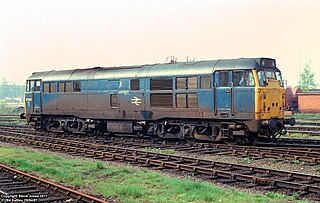
The British Rail Class 31 diesel locomotives, also known as the Brush Type 2 and previously as Class 30, were built by Brush Traction from 1957 to 1962. They were numbered in two series, D5500-D5699 and D5800-D5862. Construction of the first locomotive was completed in the final week of September 1957, and the handing-over took place on 31 October. The first Class 31 entered service in November 1957, after the launch of the Class 20 locomotive and was one of the Pilot Scheme locomotives ordered by British Railways to replace steam traction.

The British Rail Class D2/11 was a British class of locomotive designed in 1958 by Brush Traction and Beyer, Peacock & Company, which co-operated to produce five prototype diesel-electric shunting locomotives of 0-4-0 wheel arrangement. They were intended to demonstrate a new generation of diesel shunters for industrial and mainline use. Two were loaned to British Railways for trials and one, number D2999, was subsequently purchased by BR. However, no large scale orders resulted from these demonstrators.
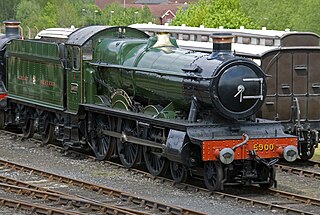
The Great Western Railway 4900 Class or Hall Class is a class of 4-6-0 mixed-traffic steam locomotives designed by Charles Collett for the Great Western Railway. A total of 259 were built at Swindon Works, numbered 4900–4999, 5900–5999 and 6900–6958. The LMS Stanier Class 5 4-6-0 and LNER Thompson Class B1 both drew heavily on design features of the Hall Class. After nationalisation in 1948, British Railways gave them the power classification 5MT.
Under the Whyte notation for the classification of steam locomotives by wheel arrangement, a 2-6-6-2 is a locomotive with one pair of unpowered leading wheels, followed by two sets of three pairs of powered driving wheels and one pair of trailing wheels. The wheel arrangement was principally used on Mallet-type articulated locomotives, although some tank locomotive examples were also built. A Garratt locomotive or Golwé locomotive with the same wheel arrangement is designated 2-6-0+0-6-2 since both engine units are pivoting.
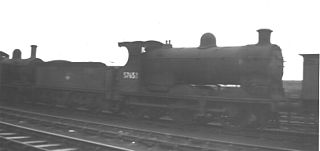
The Caledonian Railway 300 Class were freight 0-6-0 tender engines introduced in 1918 and designed by William Pickersgill. Forty-three were built between 1918 and 1920. They were numbered 294–324, 280, 281, 670–679 by the Caledonian Railway.

The Chicago and North Western Class E-4 was a class of nine streamlined 4-6-4 "Hudson" steam locomotives built in 1937 by the American Locomotive Company (ALCO).

The Furness Railway 21 class or "Larger Seagulls", were a class of eight 4-4-0 steam locomotives designed by W. F. Pettigrew and built by Sharp, Stewart and Company of Glasgow for the Furness Railway. Six were built in 1896, and two more in 1900. They were built to supersede the 120 class on the heavier and more important trains and were in turn replaced on the railway’s top trains with the 115 class in the 1920s. They had 6-foot-0-inch (1.829 m) diameter driving wheels with 18-by-24-inch cylinders.
British Rail Class D2/1 was a locomotive commissioned by British Rail in England. It was a diesel powered locomotive in the pre-TOPS period built by the North British Locomotive Company with a Paxman engine. Eight locomotives were built and they were numbered D2700-D2707.

The British Rail Class 29 were a class of 20 diesel-electric Bo-Bo locomotives produced by the re-engining of the NBL Type 2 units. The units were designed for both passenger and freight trains.
British Rail Class D3/1 was a locomotive commissioned by British Rail in England. It was a diesel powered locomotive in the pre-TOPS period built by the North British Locomotive Company. The NBL/MAN engines were built by the North British Locomotive Company in Scotland under licence from the German company MAN. They were introduced in 1958 and numbered D2900-D2913.

British Rail Class D2/10 was a locomotive type commissioned by British Rail. It was a diesel-hydraulic shunting locomotive in the pre-TOPS period built by the North British Locomotive Company (NBL). The NBL/MAN engines were built by the North British Locomotive Company in Scotland under licence from the German company MAN. They were introduced in 1957 and numbered D2708-D2780.

The North Eastern Railway Class M1 is a class of 4-4-0 steam locomotive, designed by Wilson Worsdell. 20 initial engines were built, then 30 further units were built, designated Class Q.
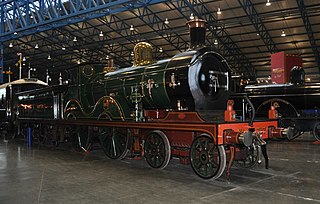
The SECR D class is a class of 4-4-0 tender locomotives designed by Harry Wainwright for the South Eastern and Chatham Railway.

The North Eastern Railway Class S was a 4-6-0 type of steam locomotive designed for express passenger workings. The first example was built in 1899. They were very similar to the NER Class S1, except for the smaller wheels of the former.

The Furness Railway 120 class or "Seagulls", were a class of four 4-4-0 steam locomotives designed by W. F. Pettigrew and built by Sharp, Stewart and Company of Glasgow for the Furness Railway in 1890.

The NBR S Class was a class of 0-6-0 steam locomotive designed by William Paton Reid for freight work on the North British Railway. The engines were initially designated as B class, being a development of the standard B class locomotives designed by Reid some eight years previously, and represented the culmination of a long evolution on the NBR of powerful 0-6-0 freight engines. The new locomotives were introduced in 1914 and had superheaters, inside cylinders and piston valves operated by Stephenson valve gear.

The NBR A Class (London and North Eastern Railway Classes N14 and N15 were the standard 0-6-2 tank locomotives designed by William P. Reid for freight duties on the North British Railway. The LNER regarded the original locomotives as two separate classes. The final batch of locomotives was on order at the time of the grouping in 1923.

The NZASM 19 Tonner 0-4-2T of 1891 was a South African steam locomotive from the pre-Union era in Transvaal.
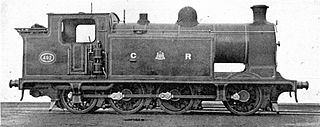
The Caledonian Railway 492 Class were a class of 6 0-8-0 tank engines that were built for the Caledonian Railway, in Scotland by St. Rollox Works from November 1903 to January 1904.

















